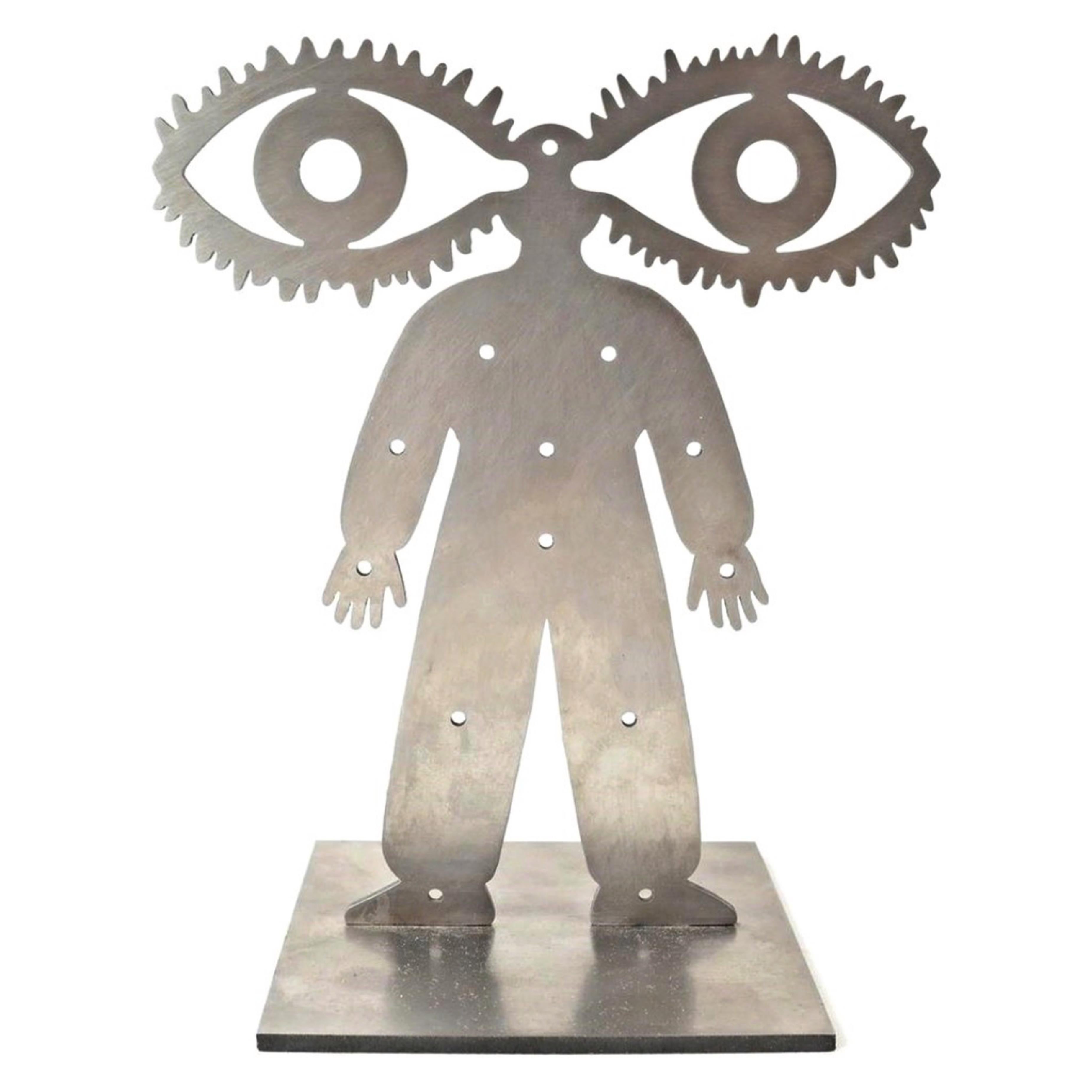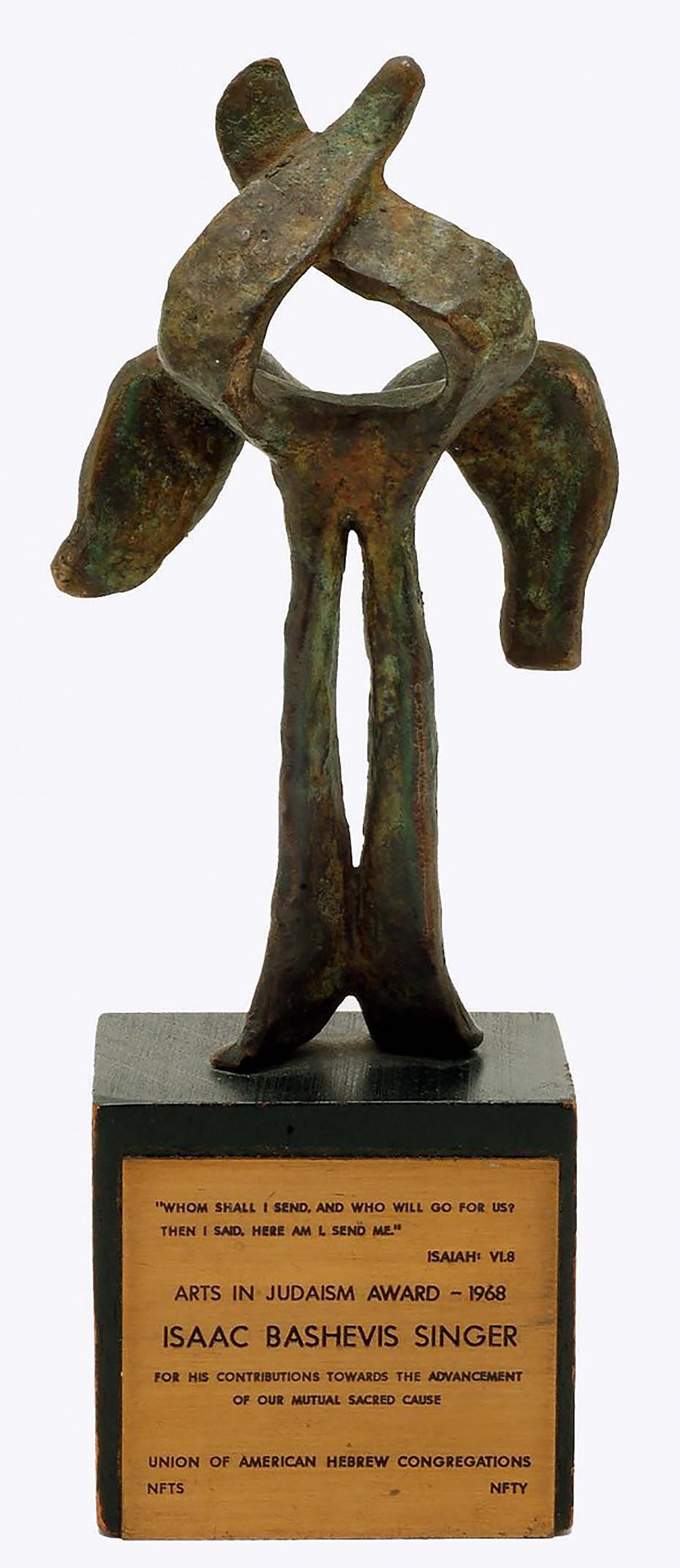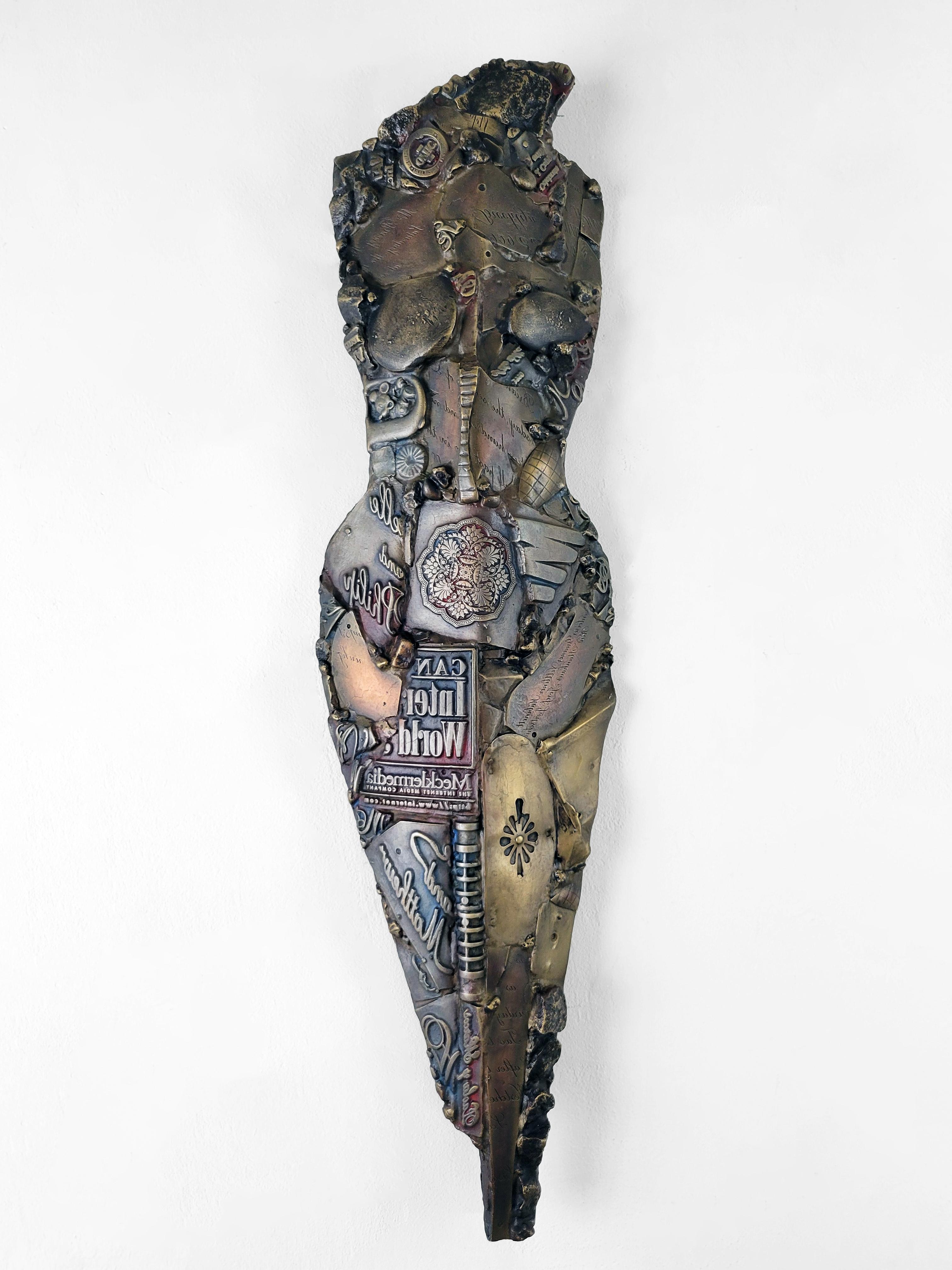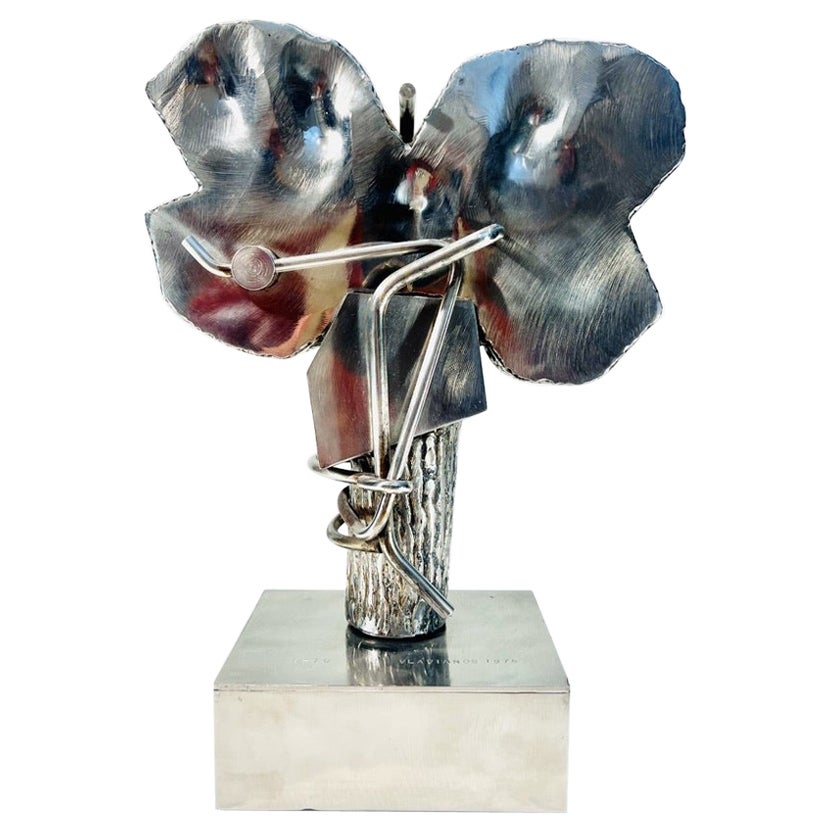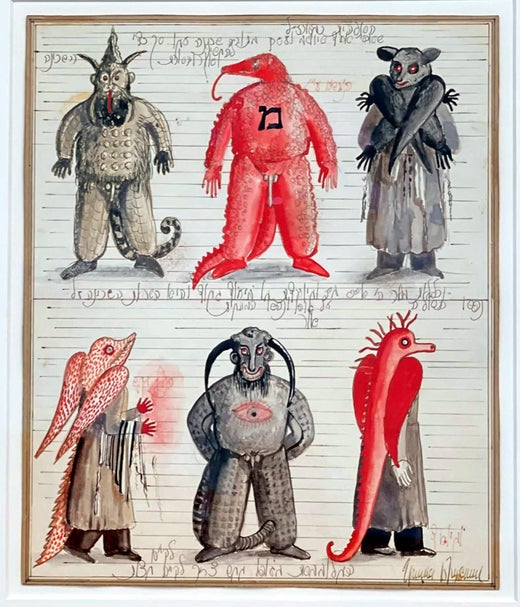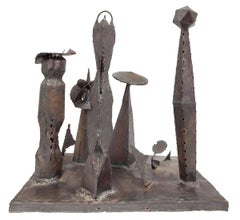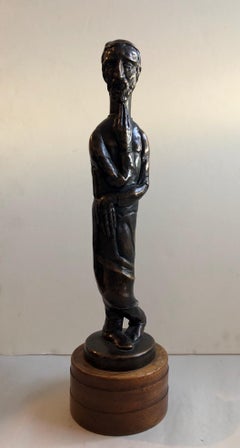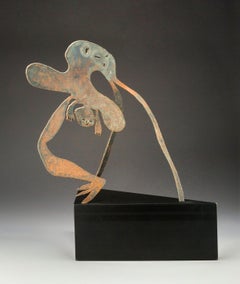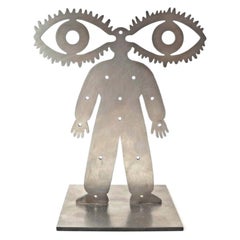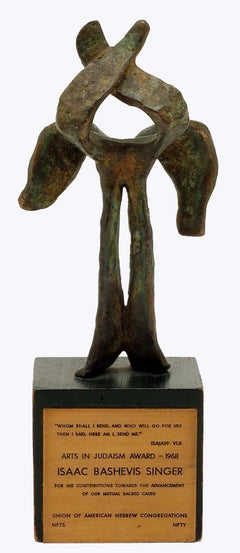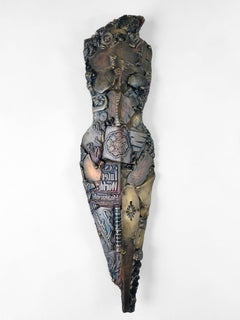Items Similar to Russian Judaica "Vision" Abstract Kabbalah Figure Steel Sculpture Grisha Bruskin
Want more images or videos?
Request additional images or videos from the seller
1 of 9
Grisha BruskinRussian Judaica "Vision" Abstract Kabbalah Figure Steel Sculpture Grisha Bruskin1992
1992
$3,800
£2,883.35
€3,296.86
CA$5,307.57
A$5,901.30
CHF 3,081.33
MX$71,833.13
NOK 39,316.44
SEK 36,837.62
DKK 24,605.04
Shipping
Retrieving quote...The 1stDibs Promise:
Authenticity Guarantee,
Money-Back Guarantee,
24-Hour Cancellation
About the Item
Grisha Bruskin
(Russian, b. 1945)
Vision, 1992
steel
Hand signed and inscribed Grisha Bruskin in Cyrillic
numbered 117/300
Genre: Contemporary
Subject: Religious
Medium: Steel
Grisha Bruskin (born October 21, 1945) is a Russian artist known as a painter, sculptor, and printmaker. He was born in Moscow. Between 1963 and 1968, he studied at the Moscow Textile Institute (Art Department). In 1969, he became a member of the Artists’ Union of the USSR. Bruskin’s participation in the famous Sotheby’s auction in Moscow (1988) brought him worldwide fame, when his piece, “Fundamental Lexicon” was sold for a record price.
He relocated to New York in 1988. In 1999, at the invitation of the German government and as a representative of Russia, Bruskin created a monumental triptych, “Life Above All” for the reconstructed Reichstag in Berlin. In 2001 he published a memoir-style book, “Past Imperfect.” In 2012 he received the Kandinsky Prize in the “Project of the Year” category, for his project, “H-Hour.” Bruskin lives and works in New York and Moscow. Part of the generation of emigre Russian artists, many Jewish, that included Yuri Kuper, Komar and Melamid, Mikhail Grobman, Eduard Steinberg, Erik Bulatov, Viktor Pivovarov, Vladimir Yankilevsky, Ilya Kabakov and Samuel Akkerman. Grisha Bruskin is a contemporary Russian artist, a member of the generation of the Post Soviet Avant Garde whose
paintings and sculptures juxtapose figures from Jewish mysticism with USSR Soviet Union-era symbols. Bruskin's series Alefbet (1984) and Fundamental Lexicon (1986), demonstrate Bruskin’s inventive use of Hasidic text, human and mystical angel figures, and creatures. Bruskin studied at the Moscow Art School and the Moscow Textile Institute. Bruskin’s works were considered controversial for their depictions of Judaic figures wearing Soviet uniforms. Bruskin represented Russia in the 57th Venice Biennale, and his works are held in the collections of the Art Institute of Chicago, The Museum of Modern Art in New York, and the State Pushkin Museum of Fine Arts in Moscow, among others. He currently lives and works between New York, NY and Moscow, Russia.
He is one of the best-known and most successful contemporary artists of Russian origins.
Select Solo Exhibitions
2017 Grisha Bruskin: Imperfetto Passato, Gallerie D’Italia, Milan, Italy
2015 Paintings and Sculpture, Meyerovich Gallery, San Francisco, California Venice Biennale
2014 H-Hour, Marlborough Gallery, New York, New York
2013 Archeologist’s Collection, Udarnik, Moscow, Russia
2012 — H-Hour, Multimedia Art Museum, Moscow, Russia
2010 — Grisha Bruskin, Alefbet, Tapestry, Musée d’art et d’histoire du Judaїsme, Paris, France
2009 New Work, Old Story: 80 Artists at the Passover Table, Contemporary Jewish Museum,
Grisha Bruskin: Twilight of the Gods, Marlborough Gallery, New York, New York
2006 — Grisha Bruskin, Archeologist’s Collection, Galerie Patrice Trigano, Paris, France Grisha
Bruskin, Alefbet, Tapestry Project, State Pushkin Museum of Fine Arts, Moscow, Russia
2001 — Grisha Bruskin, Life is Everywhere, State Russian Museum, St. Petersburg, Russia; traveled
to the State Pushkin Museum of Fine Arts, Moscow, Russia
Select Group Exhibitions
2017 — Venice Biennale, Venice, Italy
2015 — Summer Group Exhibition, Marlborough Gallery, New York
2011 — Judaism: A World of Stories, De Nieuwe Kerk Amsterdam, Amsterdam, The Netherlands
2009 — New Work, Old Story: 80 Artists at the Passover Table, The Contemporary Jewish Museum, San Francisco, California
Sculpture, Marlborough Gallery, New York, New York 1989-2009. Mur de Berlin. Artistes pour la liberté. Jardins du Palais-Royal, Paris, France The Claude and Nina Gruen Collection of Contemporary Russian Art. Jane Voorhees Zimmerli
Art Museum, New Brunswick, New Jersey Summer Exhibition, Marlborough Gallery, New York, New York
2008 Fragile Persuasion: Russian Porcelain and the Fine Art of Propaganda, Hillwood Estate
Museum & Gardens, Washington D.C. Nonconformist. The Second Russian Avant-garde 1955-1988,
2007 — Summer Exhibition, Marlborough Gallery, New York, New York Painting and Sculpture,
Sots-Art. Art politique en Russie de 1972 à Aujourd’hui, Maison rouge, Paris, France Fifty-fifty.
2006 RUSSIA! Nine Years of Masterpieces and Master Collections, Solomon R. Guggenheim
Museum, New York, New York
2002 — La Parade des Animaux, Festival International de Sculpture de Monte-Carlo, Monaco
Russian Revolutions: Generations of Russian Jewish Avant-Garde Artists, Singer Gallery, Mizel Center for Arts and Culture, Denver, Colorado
Sculpture by Magdalena Abakanowicz, Arman, Fernando Botero, Grisha Bruskin, Lynn Chadwick and others, Marlborough Gallery, New York, New York
2001 Dumbo Double Deuce; New York & Russian Artists, Brooklyn, New York
2000-2001 — Sammlung Hans & Uschi Welle, Kupferstichkabinett, Berlin, Germany
2000 Nonconformisten 1955-1988, Die Zweite Russische Avantgarde, Chronik, Germany Nilder und Fotodokumente aus der Sammlung, Bar-Gera Markisches Museum der Stadt, Witten, Germany
1998 — It’s the Real Thing - Soviet and Post-Soviet Sots Art and American Pop Art, Frederick
R.Weisman Art Museum, University of Minnesota, Minneapolis
1988 Ich lebe, Ich sehe: Künstler der achtziger Jahre in Moskau, Kunstmuseum Bern, Switzerland
Olympiad of Art, National Museum of Contemporary Art, Seoul, South Korea Sowjetkunst heute, Museum Ludwig, Cologne, Germany Glasnost - Die neue Freiheit der sowjetischen Maler, Kunsthalle Emden, Emden, Germany
Select Public Collections
Art Institute of Chicago, Chicago, Illinois
Galeria de Arte Nacional, Caracas, Venezuela
Israel Museum, Jerusalem, Israel
Jane Voorhees Zimmerli Art Museum, Rutgers University, New Brunswick, New Jersey
Jewish Museum, New York, New York
Kunsthalle Emden, Emden, Germany
Museum Ludwig, Cologne, Germany
Reichstag, Berlin, Germany
State Pushkin Museum of Fine Arts, Moscow, Russia
State Russian Museum, St. Petersburg, Russia
State Tretyakov Gallery, Moscow, Russia
The Achenbach Foundation for Graphic Arts, Fine Arts Museums of San Francisco
The Museum of Modern Art, New York, New York
- Creator:Grisha Bruskin (1945, Russian)
- Creation Year:1992
- Dimensions:Height: 6 in (15.24 cm)Width: 6 in (15.24 cm)Depth: 4 in (10.16 cm)
- Medium:
- Movement & Style:
- Period:
- Condition:minor tarnishing to surface of steel commensurate with age; overall good condition. please see photos.
- Gallery Location:Surfside, FL
- Reference Number:Seller: 24051stDibs: LU38215762212
Grisha Bruskin
Born in 1945, the Russian artist Grisha Bruskin graduated from the Art Department at the Moscow Textile Institute in 1968. As a member of the Soviet Artists' Union, he staged a number of controversial exhibitions, most of which were closed down by the Soviet authorities. Bruskin immigrated to his current home, New York City, in 1989. Refusing to adhere to the government-sanctioned style of Socialist Realism, Bruskin became a major figure in the Soviet Non-Conformist Art movement, dedicating himself to the research and presentation of his Jewish heritage and its associated mythologies, mysticism, and sacred texts. Bruskin's work juxtaposes this powerful visual vocabulary of Judaic imagery and text with symbolic remnants of the now dissolved Soviet Union. In Alefbet (1984) and Alefbet-Lexicon (1987), his most reknown painting series, Bruskin combines Hasidic text, figures in religious uniform and a slew of Jewish mystical symbols to produce an image system. Bruskin's prints continue this exploration of the conflict between religious and political mythology, investigating the point of intersection between two prescribed notions of social identity as manifested through tradition, image and text. A prolific writer as well as visual artist, Bruskin's work is included in many permanent public collections, such as The Art Institute of Chicago, Illinois; The Museum of Modern Art, New York, NY; Jewish Museum, New York, NY; Kunsthalle Emden, Germany; State Pushkin Museum of Fine Arts, Moscow, Russia; State Russian Museum, St. Petersburg, Russia, and Museo Galeria de Arte, Caracas, Venezuela.
About the Seller
4.9
Platinum Seller
Premium sellers with a 4.7+ rating and 24-hour response times
Established in 1995
1stDibs seller since 2014
1,784 sales on 1stDibs
Typical response time: <1 hour
- ShippingRetrieving quote...Shipping from: Surfside, FL
- Return Policy
Authenticity Guarantee
In the unlikely event there’s an issue with an item’s authenticity, contact us within 1 year for a full refund. DetailsMoney-Back Guarantee
If your item is not as described, is damaged in transit, or does not arrive, contact us within 7 days for a full refund. Details24-Hour Cancellation
You have a 24-hour grace period in which to reconsider your purchase, with no questions asked.Vetted Professional Sellers
Our world-class sellers must adhere to strict standards for service and quality, maintaining the integrity of our listings.Price-Match Guarantee
If you find that a seller listed the same item for a lower price elsewhere, we’ll match it.Trusted Global Delivery
Our best-in-class carrier network provides specialized shipping options worldwide, including custom delivery.More From This Seller
View All1965 Canadian Israeli Art Brutalist Abstract Welded Steel Sculpture Eli Ilan
Located in Surfside, FL
Eli Ilan (אלי אילן), 1928-1982 was an Israeli sculptor.
Abstract organic pod shape. in either steel or iron mounted on a wooden plinth.
Ilan was born in Winnipeg, Manitoba. He enrolled in a premedical curriculum at the University of British Columbia in Vancouver and emigrated to Israel in 1948. He then studied prehistoric archaeology and physical anthropology at the Hebrew University of Jerusalem. In 1956, he returned to Canada to study sculpture at the Ontario College of Art & Design. He lived in Kibbutz Sasa from 1959 to 1963. He died in 1982 in Caesarea, Israel.
Education
1955 Hebrew University, Jerusalem, pre-historic archaeology and physical anthropology
1956 Ontario College of Art, Toronto, Canada, sculpture under Thomas Bowie
1959 Training College, Ottawa, criminal identification techniques
1969 Art Festival, Painting & Sculpture in Israel. Ganei Hataarucha, Tel Aviv
Artists: Chana Orloff, Eli Ilan, Zvi Aldouby, Jacob El Hanani, Ludwig Blum, Aharon Bezalel, Koki Doktori, Israel Hadany, Marcel Janco, Dov Feigin, Abel Pann, Esther Peretz Arad, Reuven Rubin, Ivan Schwebel, Jakob Steinhardt, Boris Schatz, Bezalel (Lilik) Schatz, Louise Schatz...
Category
1960s Abstract Abstract Sculptures
Materials
Stainless Steel
Mid Century Modern Brutalist Welded Expressionist Sculpture After Paul Evans
Located in Surfside, FL
In this bronze sculpture the artist (unknown) has welded together a group of totems or monuments into a unified piece. T
Neo-Dada Abstract Sculpture: Assemblages
In contrast, abstra...
Category
Mid-20th Century Abstract Expressionist Abstract Sculptures
Materials
Metal
Art Deco Expressionist Bronze Judaica Rabbi Sculpture Los Angeles Modernist
By Peter Krasnow
Located in Surfside, FL
Bronze Jewish Rabbi. Original Patina. Art-deco wood carved base. It is signed with initials P.K. and marked "Calif Art Bronze Fdry LA" (California Art Bronze Foundry Los Angeles). it is not dated.
PETER KRASNOW (1886-1979), Russian-Ukrainian, American artist painter and sculptor, born Feivish Reisberg, was a California modernist and colorist artist known for his abstract wood sculptures and architectonic hard-edge paintings and drawings which were often based on Hebrew calligraphy and other subjects related to his Jewish heritage...
Category
1930s Expressionist Figurative Sculptures
Materials
Bronze
Large 1970's Israeli Abstract Sculpture "Birth" Iron, Wood Menashe Kadishman
By Menashe Kadishman
Located in Surfside, FL
Menashe Kadishman (Israeli, 1932-2015)
Birth
Iron
17-1/2 inches (44.5 cm) high on a 6-1/4 inches (15.9 cm) high wood base
Hand signed and Inscribed on base
Sculpture with base measur...
Category
1990s Abstract Expressionist Abstract Sculptures
Materials
Iron
Large Modern Abstract Figure Polished Steel Mod Chrome Sculpture Jack Schuyler
Located in Surfside, FL
Jack Schuyler (1912-2002) Polished Metal Sculpture "Abstract Figural Composition" Hand signed and Dated 1982.
Measures 27" x 26-1/2" x 10.5" inches.
There is not much known about t...
Category
1980s Post-Modern Abstract Sculptures
Materials
Stainless Steel
Israeli Abstract Figures Art Brut Polychromed Bronze Sculpture Aharon Bezalel
By Aharon Bezalel
Located in Surfside, FL
Aharon Bezalel (born Afghanistan 1926) Born in Afghanistan in 1926 and immigrated to Israel at an early age. As a youth was engaged as a silversmith and craftsman, and was a student of the sculptor Zev Ben-Zvi from whom he absorbed the basic concepts of classic and modernist art and interpreted, according to them, ideas based on ancient Hebrew sources.
Aharon Bezalel works and resides in Jerusalem, he taught art for many years.
“I saw myself as part of this region. I wanted to find the contact between my art and my surroundings. Those were the first years of Jean Piro’s excavations at the Beer-Sheba mound. They found there, for example, the Canaanite figurines that I especially liked and that were an element that connected me with the past and with this place.” “…a seed and sperm or male and female. These continue life. The singular, the individual alone, cannot exist; I learned this from my father who dabbled with the Kabbalah.”
(Aharon Bezalel, excerpt from an interview with David Gerstein)
“The singular in Aharon Bezalel’s work is always potentially a couple if not a threesome[…] the one is also the many: when the individual is revealed within the group he will always seek a huddling, a clinging together.
The principle of modular construction is required by this perception of unity and multiplicity, as modular construction in his work is an act of conception or defense.
Two poles of unity, potentially alone, exist in A. Bezalel’s world: From a formal, sculptural sense these are the sphere and pillar, metaphorically these are the female in the final stages of pregnancy and the solitary male individual. Sphere-seed-woman; Pillar-strand-man. The disproportional, small heads in A. Bezalel’s figures leave humankind in it’s primal physical capacity. The woman as a pregnancy or hips, the man as an aggressive or defensive force, the elongated chest serves as a phallus and weapon simultaneously.
(Gideon Ofrat)
EIN HAROD About the Museum's Holdings: Israeli art is represented by the works of Reuven Rubin, Zaritzky, Nahum Gutman...
Category
1960s Expressionist Abstract Sculptures
Materials
Bronze
You May Also Like
Adam Kadmon ("Vision"), Kabbalistic Jewish Russian sculpture signed & inscribed
By Grisha Bruskin
Located in New York, NY
Grisha Bruskin
Adam Kadmon (Vision), Signed and signed dedicated to art historian and collector Jacob Baal Teshuva), 1992
Steel Sculpture
(Signed, Dated & Dedicated)
6 × 6 × 3 inche...
Category
1990s Surrealist Figurative Sculptures
Materials
Steel
Y - Haude Bernabé, 21st Century, Contemporary metal sculpture, figure
By Haude Bernabé
Located in Paris, FR
Born in Brest and with a scientific background, Haude Bernabé has devoted herself to art since the early 1990s. Her first passion was art, the second one...
Category
2010s Contemporary Figurative Sculptures
Materials
Metal
Bronze Sculpture to Isaac Bashevis Singer, Arts in Judaism Award signed Judaica
By Nathaniel Kaz
Located in New York, NY
Nathaniel Kaz
Bronze Sculpture to Isaac Bashevis Singer for Arts in Judaism Award, 1966
Bronze, Square wooden base, Metal tag
Signed and dated "66" to back of bronze portion of the w...
Category
1960s Abstract Expressionist Abstract Sculptures
Materials
Metal, Bronze
Linda Stein, Heroic Vision 568 - Contemporary Art Bronze Sculpture Edition
Located in New York, NY
Heroic Vision 568 from Linda Stein’s Knights of Protection series functions both as a defender in battle and a symbol of pacifism. This sculpture is made of bronze and is from an ed...
Category
Early 2000s Contemporary Abstract Sculptures
Materials
Bronze
$4,800 Sale Price
20% Off
Moonshine - Haude Bernabé, 21st Century, Contemporary metal sculpture, figure
By Haude Bernabé
Located in Paris, FR
Steel sculpture
Unique work
Signed on the base
Born in Brest and with a scientific background, Haude Bernabé has devoted herself to art since the early ...
Category
2010s Contemporary Figurative Sculptures
Materials
Steel
Steel sculpture by Nicolas Vlavianos 1970
By Nicolas Vlavianos
Located in Rio De Janeiro, RJ
Stell sculture by Nicolas Vlavianos.
Category
Vintage 1970s Greek Expressionist Abstract Sculptures
Materials
Steel
